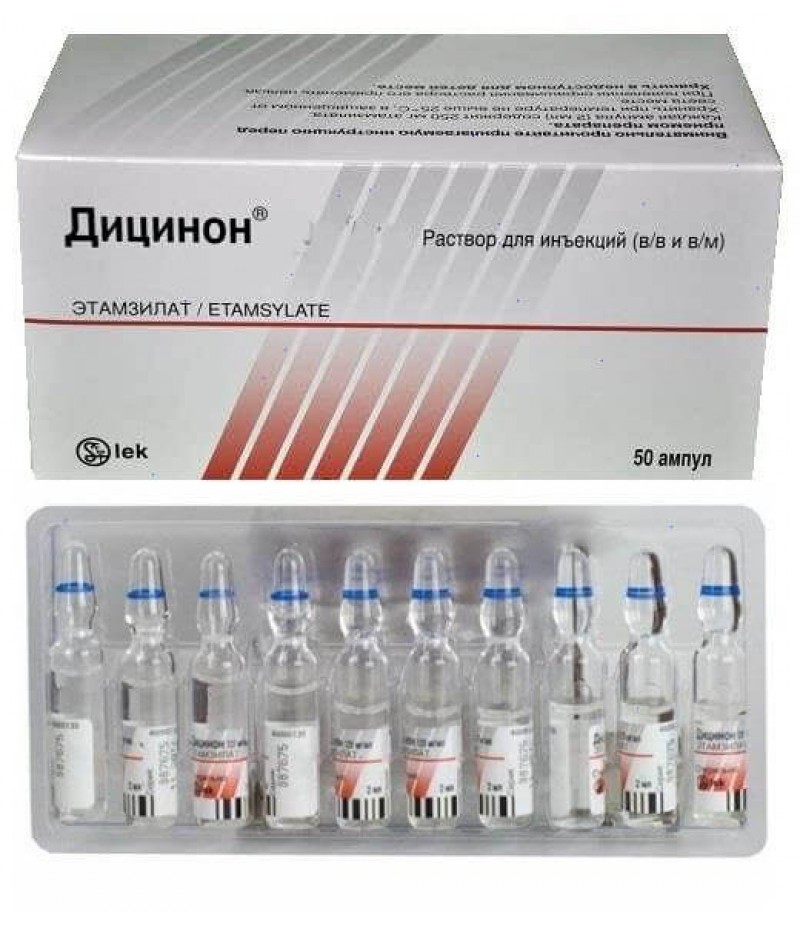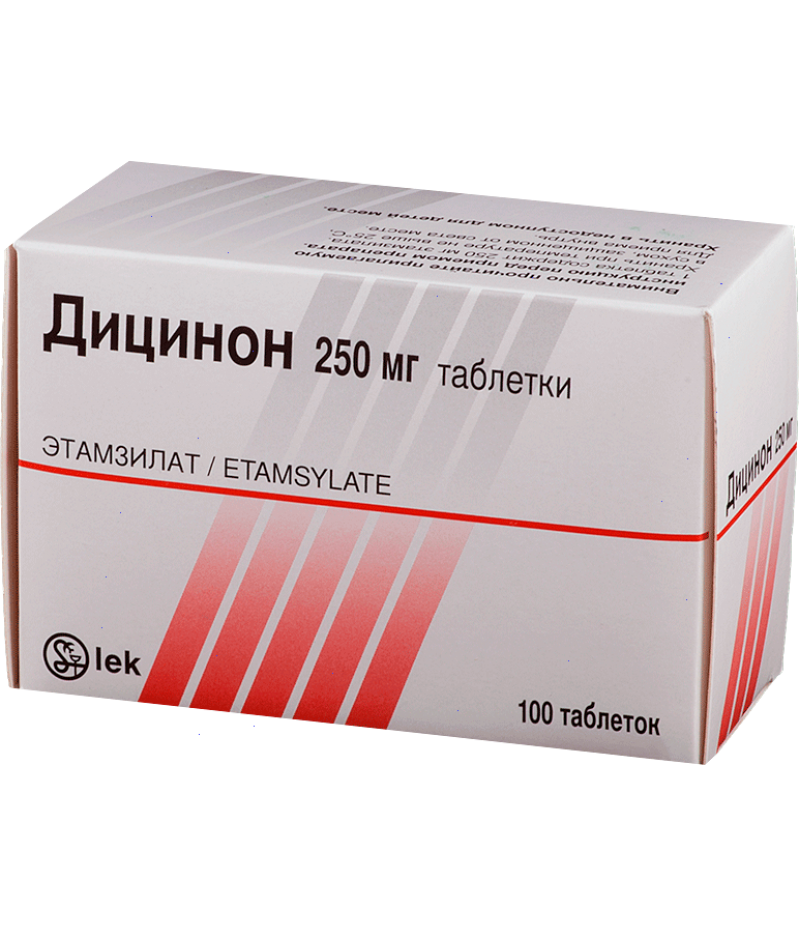Dicynone solution for injections 125mg/ml 2ml #50
- $36.22
- 3 or more $35.99
- Availability:In Stock
Dicynone instruction for useReed more and buy Dicynone on this pageRelease form, composition and packagingSolution for in / in and in / m the introduction of colorless, transparent.1 ml of 1 amp.Etamzilat 125 mg 250 mgExcipients: ..
Tags: solution
Dicynone instruction for use
Reed more and buy Dicynone on this page
Release form, composition and packaging
Solution for in / in and in / m the introduction of colorless, transparent.
1 ml of 1 amp.
Etamzilat 125 mg 250 mg
Excipients: sodium disulfite, water d / and sodium bicarbonate (used in some cases for pH adjustment).
2 ml - ampoules of colorless glass (10) - blisters (5) - packs cardboard.
pharmachologic effect
Hemostatic drug. Dicynone increases the formation of large molecular weight mucopolysaccharides in the capillary walls and increases the stability of capillaries, normalizes their permeability during pathological processes, improves microcirculation. It has a hemostatic effect, which is caused by the activation of the formation of thromboplastin at the site of damage to small vessels. Dicynone stimulates the formation of coagulation factor III, normalizes the adhesion of platelets. Dicynone does not affect the prothrombin time, does not have hypercoagulable properties and does not contribute to the formation of blood clots.
After the on / in the drug begins to act in 5-15 minutes; the maximum effect is observed after 1 hour, the duration of action is 4-6 hours.
Pharmacokinetics
Suction and distribution
After the on / in the introduction of Dicynone in a dose of 500 mg Cmax is reached after 10 minutes and is 50 μg / ml.
After ingestion, the drug is rapidly and almost completely absorbed. After taking Dicynone in a dose of 50 mg Cmax is reached after 4 hours and is 15 μg / ml.
Etamzilat penetrates the placental barrier and is excreted in breast milk.
Removal
About 72% of the administered dose is excreted by the kidneys during the first 24 hours unchanged.
After the on / in the introduction of T1 / 2 is about 2 hours, after oral administration T1 / 2 is about 8 hours.
Indications for Dicynone injections
Prevention and treatment of capillary bleeding of various etiologies:
- during and after surgical operations on all well vascularized tissues in otolaryngology, gynecology, obstetrics, urology, dentistry, ophthalmology and plastic surgery;
- hematuria, metrorrhagia, primary menorrhagia, menorrhagia in women with intrauterine contraceptives, nosebleeds, bleeding gums;
- diabetic microangiopathy (hemorrhagic diabetic retinopathy, repeated hemorrhages in the retina, hemophthalmus);
- intracranial hemorrhage in newborns and premature babies.
Contraindications for solution Dicynone
- acute porphyria;
- hemoblastosis in children (lymphoblastic and myeloblastic leukemia, osteosarcoma);
- thrombosis;
- thromboembolism;
- Hypersensitivity to the components of the drug and sodium sulfite;
- hypersensitivity to sodium sulfite (solution for IV and IM injection).
With caution should be prescribed Dicynone for thrombosis, thromboembolism in history, bleeding in the background of an overdose of anticoagulants.
Dosage
The optimal daily intake for adults is 10–20 mg / kg, divided into 3–4 intramuscular or intravenous (slow) injections.
During surgery, adults are given a prophylactic 250-500 mg intravenously / intramuscularly or intramuscularly 1 hour before surgery. During the operation, 250-500 mg are administered intravenously; the introduction of this dose can be repeated once more. After surgery, 250-500 mg is administered every 6 hours until the risk of bleeding has disappeared.
For children, the daily dose is 10-15 mg / kg of body weight, divided into 3-4 administrations.
In neonatology: Dicynone is administered intramuscularly or intravenously (slowly) at a dose of 12.5 mg / kg (0.1 ml = 12.5 mg). Treatment should begin within the first 2 h after birth.
If Dicynone mixed with saline, then it should be entered immediately.
Side effects
From the side of the central nervous system and peripheral nervous system: headache, dizziness, paresthesia of the lower extremities.
On the part of the digestive system: nausea, heartburn, heaviness in the epigastric region.
Others: allergic reactions, flushing of the skin of the face, reduction of systolic blood pressure.
Overdose
Data overdose Dicynone not provided.
Drug interaction
The introduction of a dose of 10 mg / kg body weight for 1 hour before the introduction of dextrans prevents their antiplatelet effect. Introduction Ditsinona after the introduction of dextrans has no hemostatic effect.
Perhaps a combination with aminocaproic acid and sodium menadione bisulfite.
Pharmaceutical Interaction
Pharmaceutically incompatible (in the same syringe) with other drugs.
Incompatible with sodium bicarbonate solution for injection and sodium lactate solution.
special instructions
Before starting treatment, other causes of bleeding should be excluded.
With the appearance of staining solution for the / m and / in the introduction, it can not be used.
The solution for the / m and / in the introduction is intended only for use in hospitals and clinics.
The solution for i / m and / in injections can be applied topically: a sterile swab or gauze cloth is impregnated with a solution and applied to the wound (for example, skin graft, tooth extraction).
Influence on ability to drive motor transport and control mechanisms
No special precautions required.
Pregnancy and lactation
Use during pregnancy is possible only in cases where the potential benefit of therapy for the mother outweighs the possible risk to the fetus.
If necessary, the appointment of the drug during lactation should decide on the termination of breastfeeding.
Use in childhood
May be used according to the indications and doses adjusted according to the age of the patient.
Pharmacy sales terms
You can buy Dicynone without a prescription.
Terms and conditions of storage
The solution for IM and IV injection should be kept out of the reach of children, protected from light at a temperature not exceeding 25 ° C. Shelf life - 5 years.


